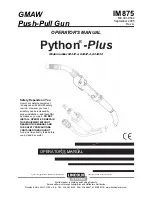
32
SECTION 4
OPERATION
Step 6. Set the shielding gas flow rate to 35 cfh by activating the gas purge
switch on the wire feeder or pulling the gun trigger and turning the
adjustment knob on the Flowmeter
Step 7 Set the voltage knob on the wire feeder to the "5" or center 12 o'clock
position.
Step 8. Connect the work cable to the workpiece and pull the gun trigger to
start welding.
Step 9 The voltage knob on the wire feeder becomes the ARC TRIM and is
used to fine tune the arc length for best arc performance. Turn the
knob clockwise to increase the arc length or counterclockwise to de-
crease the arc. Trim the wire speed and volts as needed for the de-
sired arc characteristics and weld quality.
2. PULSE PROCESS CONTROL
1.Use a tip-to-work distance (TTW) of 3/8" to 5/8". This refers to the dis-
tance between the end of the Mig gun contact tip and the workpiece or
weld puddle. The tip-to-work distance can also be used to adjust the
stability of the arc. Changes in distance wil cause the arc to shorten or
lengthen as desired for best results. Excessive tip to work movement
can cause arc instability. Maintaining a constant TTW will insure the
best arc stability and consistency.
2.For the best arc stability, keep the arc on the front edge of the molten
puddle and use a 5 to 10 degree gun angle from the vertical.
3.If the arc is "crackling" or if spatter is excessive lengthen the arc by
adjusting the TRIM knob . If the arc is "fluttering" or difficult to control
then shorten the arc length.
3. PULSE MIG ARC STABILITY
Many variables can affect the arc stability of pulse MIG welding. Some
examples are:
Differences in shielding gas compositions
Differences in weld wire chemistry
Water vs. air cooled guns
Base metal surface condition
Tip-to work distance
Variations on wire feed speed
Wire feedability
Long welding cables
High resistance cables and connections
When adverse conditions are present, the pulse arc stability is sometimes less
than desirable. The arc will "crackle" and produce higher than normal spatter
levels. This occurs when high resistances in the welding circuit cause changes
pulse waveform and average current levels. The TRIM knob adjusts the pulse
frequency to accommodate small changes in the welding equipment set-up and
base material variations to achieve a stable pulse welding condition. Mechani-
cal wire feed inconsistencies will also affect pulse arc stability.
Содержание MultiPower 460 Pulse
Страница 4: ...4 TABLE OF CONTENTS ...
Страница 18: ...18 DESCRIPTION SECTION 2 ...
Страница 24: ...24 INSTALLATION SECTION 3 ...
Страница 37: ...37 Schematic Diagram Section 1 MultiPower 460 230 460 575V 0558003034 C ...
Страница 38: ...38 Schematic Diagram Section 2 MultiPower 460 230 460 575V 0558003034 C ...
Страница 39: ...39 Schematic Diagram Section 3 MultiPower 460 230 460 575V 0558003034 C ...
Страница 40: ...40 Wiring Diagram Section 1 MultiPower 460 230 460 575V 0558003064 D ...
Страница 41: ...41 Wiring Diagram Section 2 MultiPower 460 230 460 575V 0558003064 D ...
Страница 42: ...42 Wiring Diagram Section 3 MultiPower 460 230 460 575V 0558003064 D ...
















































